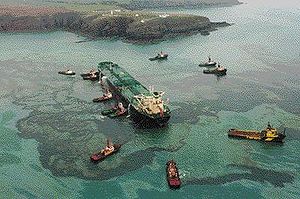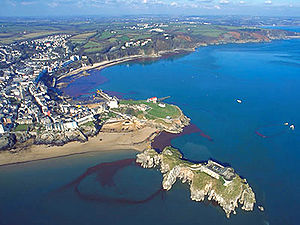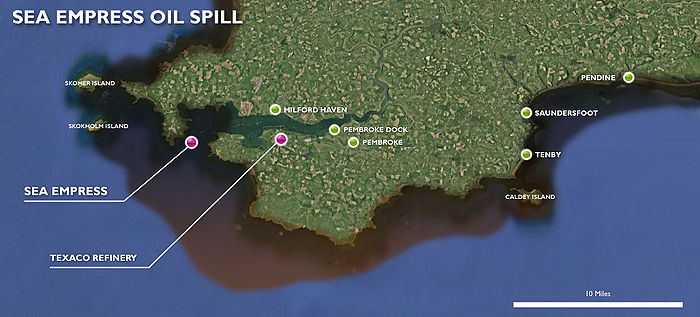Sea Empress Disaster

| |
| Career | |
|---|---|
| Name: | Sea Empress |
| Owner: | Alegrete Shipping Co, Inc., Monrovia |
| Port of registry: | Template:LBR |
| Builder: | Astilleros Españoles, Cádiz, Spain |
| Completed: | 1993 |
| Out of service: | 2004 |
| Status: | floating storage and offloading unit in Chittagong |
| General characteristics | |
| Class and type: | Suezmax |
| Tonnage: | 147,273 DWT |
| Length: | 274.3 m (899.93 ft) |
| Beam: | 43.2 m (141.73 ft) |
| Draft: | 17.02 m (55.84 ft) |
| Propulsion: | direct-drive diesel, single propeller |
| Speed: | 15 knots (28 km/h) |
| Capacity: | 164,156 m3 (1,003,035.33 imp bbl) |
The Sea Empress oil spill occurred at the entrance to the Milford Haven Waterway in Pembrokeshire, Wales on 15 February 1996, when the Sea Empress, heading to the Texaco oil refinery near Pembroke, hit mid-channel rocks at St. Ann's Head and spilled 73,000 tonnes of crude oil. The spill occurred within the Pembrokeshire Coast National Park - one of Europe's most important and sensitive wildlife and marine conservation areas. It remains one of Britain's worst environmental disasters.
Grounding
Just after 20:00 GMT on the evening of Thursday, 15 February 1996 the Sea Empress was entering the Milford Haven Waterway at St. Anns Head en-route from the North Sea to deliver 130,000 tonnes of North Sea crude to the Texaco oil refinery (now Chevron) near Pembroke.
Sailing against the outgoing tide, at 20:07 GMT the ship was pushed off course by the current, and hit rocks in the middle of the channel, which punctured her starboard hull causing oil to pour out into the sea. Tugs from Milford Haven Port Authority were sent to the scene to try and pull vessel from the rocks and re-float her. During the initial rescue attempts, she became detached several times from the tugs and became grounded repeatedly - each time slicing open new sections of her hull and releasing more oil.

A full scale emergency plan was activated by the authorities, and news of the grounding was first reported at 21:18 on the BBC's Nine O'Clock News - just over an hour after she ran aground. At the same time, people in Pembroke (10 miles east of the Sea Empress) reported a strong smell of petrol or oil in the air and some were checking cars for a possible fuel leak due to the strength of the smell.
Over the next few days, frantic efforts to pull the vessel from the rocks continued with tugboats drafted in from the ports of Dublin, Liverpool and Plymouth to assist with the salvage operation.
Nearly a week after her initial grounding and after spilling 73,000 tonnes of oil into the ecologically sensitive waters of the Pembrokeshire coast, The Sea Empress was successfully pulled free from the rocks. She was then towed to berth at a disused jetty in the Milford Haven waterway to have her remaining 57,000 tonnes of oil pumped out for refining. She remained berthed in the haven for six weeks before being towed to Belfast for repair.
Environmental Impact
The Sea Empress disaster occurred in Britain's only coastal national park and in one of only three UK marine nature reserves. The tanker ran aground very close to the islands of Skomer and Skokholm - both national nature reserves, Sites of Special Scientific Interest (SSSI) and special protection areas and home to Manx Shearwaters, Atlantic Puffins, Guillemots, Razorbills, Great Cormorants, Kittiwakes, European Storm-petrels, Common Shags and Eurasian Oystercatchers.
Birds at sea were hit hard during the early weeks of the spill, resulting in thousands of deaths. The Pembrokeshire grey seal population didn't appear to be affected too much and impacts to subtidal wildlife were limited. However, much damage was caused to shorelines affected by bulk oil. Shore seaweeds and invertebrates were killed in large quantities. Mass strandings of cockles and other shellfish occurred on sandy beaches. Rock pool fish were also affected. However, a range of tough shore species were seen to survive exposure to bulk oil and lingering residues.
A rescue centre for oiled birds was set up in Milford Haven and according to the Countryside Council for Wales (CCW), over 70% of released guilllemots died within 14 days, only about 3% survived two months and only 1% survived twelve months.
The Pembrokeshire coast is home to common porpoises and bottlenose dolphins. The effects of the oil and chemical pollution on these species remains unknown. Significant numbers of both species were recorded in the waters off the Skomer Marine Nature Reserve during the spring and summer of 1996.
The main containment and dispersement of the oil slick at sea was completed within six weeks but the removal of oil on shore took over a year until April and May 1997. Small amounts of oil were still found beneath the sand on sheltered beaches and in rock pools in 1999 - three years after the spill.
The effects of the spill were not as bad as initially predicted. This was due in part to the time of year when the spill occurred. In February, many migratory animals had not yet arrived back in Pembrokeshire for breeding. Along with stormy weather which helped break-up and naturally disperse the oil, the effect on wildlife would have been much worse if the spill had occurred just a month later and catastrophic for both the environment and local economy if it had occurred in summer
Much of the Pembrokeshire coastline recovered relatively quickly. By 2001, the affected marine wildlife population levels had more-or-less returned to normal.
Economic Impact
There was an immediate ban on fishing off the coast of Pembrokeshire and south Carmarthenshire which had a devastating impact on the local fishing industry. The ban remained in place for several months and was lifted in stages. Many local fishermen received financial compensation for the loss of income due to the ban.
The spill occurred just a few weeks before the Easter break when many holidaymakers would be visiting the area. Some sheltered beaches and tidal estuaries were still covered with oil, but the main tourist locations of Tenby, Saundersfoot, Pendine, Manorbier and Bosherston were superficially cleaned.
Clean-Up
A large clean-up operation began as soon as the Sea Empress started spilling oil. In the immediate days and weeks that followed, nearly a thousand people worked around the clock to rescue oiled birds and remove oil from beaches using suction tankers, pressure washers and oil-absorbing scrubbers. The main clean-up operation lasted several weeks and continued on a small scale for over a year.
Aftermath
In January 1999, Milford Haven Port Authority (MHPA) was fined a record £4m after pleading guilty to the offence of causing pollution under the Water Resources Act 1991 and was also required to pay a further £825,000 prosecution costs by agreement.
The logistical financial cost of the oil spill was estimated to be £60m. When the effects to the economy and environment are taken into account, the final cost is estimated to have been twice that at £120m.
Following the spill, The Sea Empress was repaired and re-named twice and was decommissioned from service in 2004 and sold in Chittagong as a floating production, storage and offloading unit (FPSO) where she remains today. In the eight years between 1996 and 2004, she was banned from entering Milford Haven and never again visited Pembrokeshire.
See Also
- Braer - Another single-hulled oil tanker which ran aground off the Shetland Islands in 1993 spilling 56,000 tonnes of oil.
- Torrey Canyon - Ran aground off the coast of Cornwall in 1969. It was en-route to Milford Haven.
- MT Haven - (Formerly known as Amocco Milford Haven) a supertanker which sank off the coast of Genoa, Italy in 1991.
- http://www.aukevisser.nl/uk/id290.htm Esso Portsmouth which exploded in July 1960, whilst berthed in Milford Haven.
- http://www.cedre.fr/en/spill/christos_bitas/christos_bitas.php Christos Bitas tanker which ran aground 10 miles off the coast of Pembrokeshire in 1978, spilling 4000 tonnes of oil.

